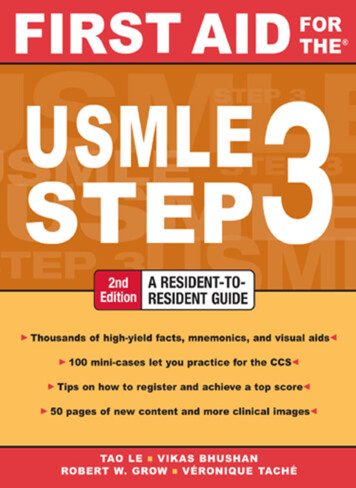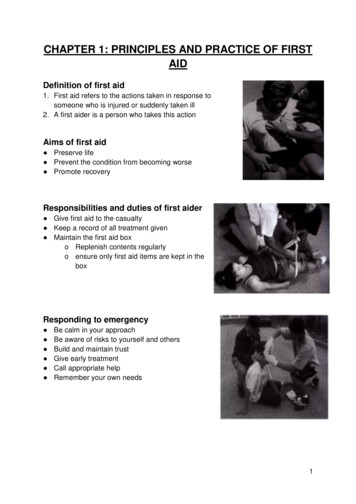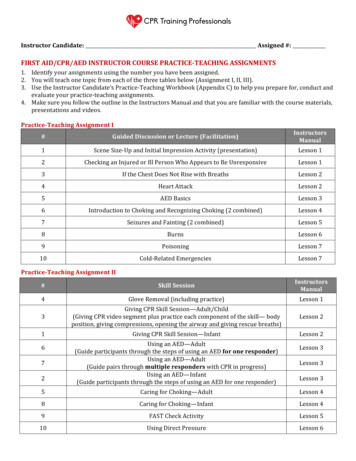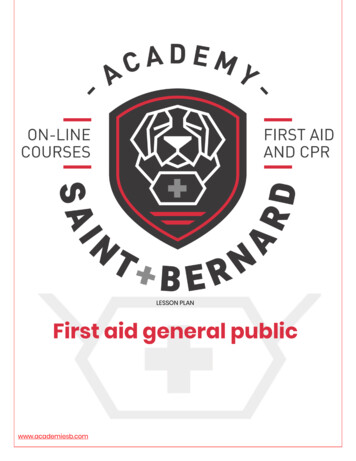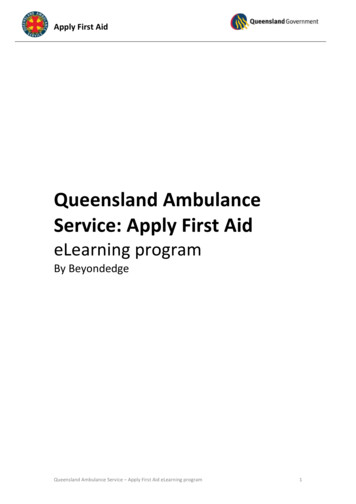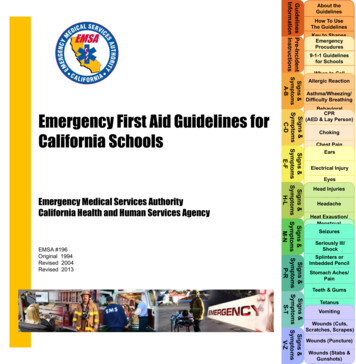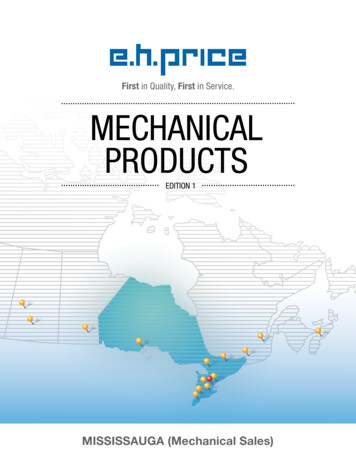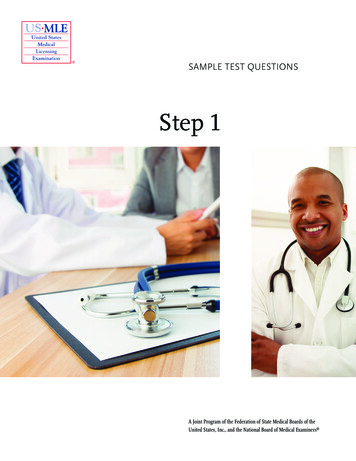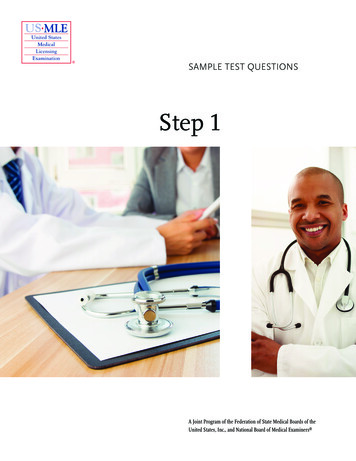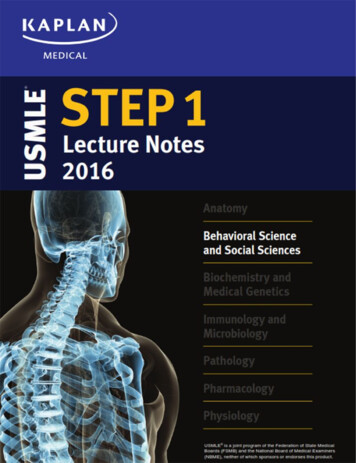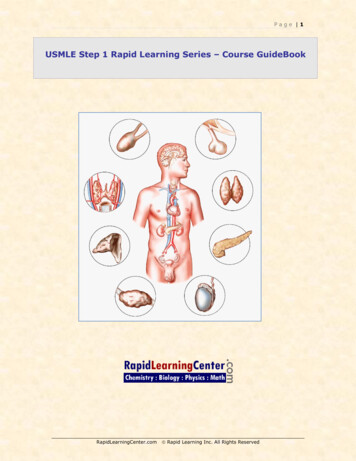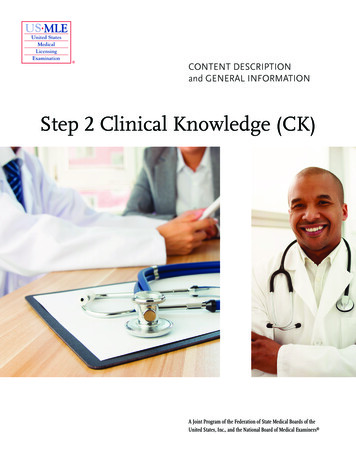
Transcription
First Aid for the USMLE Step 1:The Really Short VersionThePath to250Tao Le, MD, MHSAssociate Clinical ProfessorChief, Section of Allergy & ImmunologyUniversity of LouisvilleSenior EditorFirst Aid Board SeriesFounder and Chief Education OfficerUSMLE-Rx/ScholarRx
Relax.
Overview§§§§§§§§§USMLE Step 1 – The BasicsDefining Your GoalsTimelines for StudyApproaching Each SubjectChoosing Prep ResourcesMore TipsOverview of First Aid/USMLE-RxSpecial OfferQ&A
?Relax.Poll Question
USMLE Step 1 – The Basics 8 hours total 280 questions in 7one-hour blocks 40 questions perblock 45 minutes of breaktime
§ Best answer§ Multimedia§ Clinical vignettesQuestionTypes§ 70-80% of exam§ Multi-step reasoningA 32-year-old Caucasian womanpresents with a 5 day history ofoccasional double vision and bilateralptosis. What is the most appropriatediagnostic test?
ScoresandPassingRates§ Passing is 194§ Mean is 229§ 20 points is 1 SD§ Allopathic med students§ 96% pass on first try§ 99% eventually pass§ Osteopathic med students§ 95% pass on first try§ IMGs§ 78% pass on first try
USMLEPercentileswww.usmle.org
Defining Your Goals§ Just pass the exam à 210 – 229§ Beat the mean à 230 – 249§ Ace the exam à 250 § “ROAD to Riches”§ Radiology/Radiation Oncology§ Ortho/Ophtho/Otolaryngo/Urology§ “Aesthetic” Surgery (plastics)§ Dermatology
NRMP: Charting Outcomes in the Match
NRMP: Charting Outcomes in the Match
?Relax.Poll Question
The “Just Pass”Schedule – 1 to2 months First Aid High Yield Facts Crammable subjects Review questions – 2 question banksThe “Gunner”Schedule – 2 to6 months All of the above, plus: Less crammable subjects More review questions – 2-3 question banksTimeline for Study
Choosing Study StrategiesYour learning preferencesStructure and characteristics of the subjectStructure and characteristics of your curriculumTime assigned to a particular subject or system
Anatomy§ Traditional anatomy is low yield§ Know anatomy for specific diseases,traumatic injuries, procedures, andcommon surgeries§ Neuroanatomy, embryology, basiccross sectional anatomy is high-yield§ Be able to identify structures on Xrays, CTs, MRIs, electronmicrographs, and photomicrographs
Biochemistry§ Crammable!!§ High yield topics include vitamindeficiencies, diseases of geneticerrors, and key regulatory enzymes§ Understand the“pathobiochemistry”§ Be familiar with medically relevantlaboratory techniques
Microbiology&Immunology§ Crammable!!§ 40% bacteriology, 25% immunology,25% virology, and 5% parasitology.So don’t fixate on bacteriology!§ Focus on distinguishingcharacteristics, target organs,method of spread, and diagnosis§ Know the immune response,vaccines, immunodeficiency diseases§ Know viral structures and genome
Pathology§ Huge but important topic§ Know hallmark characteristics ofeach disease including signs andsymptoms§ Look for clues in age, sex, ethnicity,and activity§ Know descriptions of “trigger”words§ Most questions with grossspecimens and photomicrographscan be answered from the historyalone
Pharmacology§ Crammable!!§ Focus on prototypic drugs; forgetobscure derivatives, trade names,dosages§ Major categories are ANS, CNS,antimicrobial, cardiovascular, andoncology§ Mechanisms, clinical uses, andtoxicities are high-yield§ Review associated biochemistry,physiology and microbiology
Physiology§ Concept oriented§ Diagrams work well in physiology§ Know basic physiologicrelationships, hormones§ Many clinical vignettes incorporatepathophysiology
Psychiatry§ Includes psychology, sociology,psychopharmacology§ High-yield- personality,psychosomatic/ somatoform,substance abuse, eating disorders
Public Health§ Mix of biostats, epidemiology, ethics,law, healthcare delivery, patientsafety, and quality improvement§ Biostats and epidemiology is veryhigh-yield§ Doctor-patient interactions
ReviewResources§ Text reviews§ Test banks§ Self-test reviews§ Case-based reviews§ Review courses§ Other media§ Flash cards§ Videos§ Mobile apps
Check out the book reviews in FirstAid for the USMLE Step 1 (Section4)PickingandChoosingResourcesBuy books/apps/resources earlyBuy only what you can useDon’t blindly buy a whole series
?Relax.Poll Question
Study Tips§ Establish a study schedule andstick with it§ Integrate and apply everything§ Save “crammable” subjects forthe end§ Focus on high yield material andpreviously learned material§ Allow time in schedule forbreaks, exercise, and personalissues§ Stay relaxed and grounded§ Use our checklist to keep you ontrack
CBT Tips§ Be very familiar with theCBT tutorial§ Know the keyboardshortcuts§ Use computerized practicetests in addition to paperexams§ Mix Q&A throughout and atthe end
www.nytimes.com
CBT Practice OptionsTypesSuggested UseUSMLE sample testFormat familiarityNBME/CBSSABenchmarkingCommercial testbanksPractice/studySimulation
MoreResearch§ Deng et al, 2015§ Qbanks Flashcards§ 445 MCQs à 1 pt on Step 1§ Burk-Rafel et al, 2017§ 3200 MCQs – bestperformance§ Unique MCQs repeat MCQs§ 3 passes in FA à USMLEscore
Test Day Tips§ Less coffee on test day§ Layered clothing§ Read lead-in first for longquestions§ Manage the clock§ Light lunch§ The “C” reflex§ P MD/DO
Let’s rstaidteam.comTwitter: @firstaidteamInstagram: @firstaidteam
Questions and Answers
USMLE-Rx/ScholarRx. Relax. Overview §USMLE Step 1 –The Basics §Defining Your Goals §Timelines for Study §Approaching Each Subject §Choosing Prep Resources §More Tips §Overview of First Aid/USMLE-Rx §Special Offer §Q&A. Relax.? Poll Question. USMLE Step 1 –The Basics 8 hours total 280 questions in 7 one-hour blocks 40questions per block 45 minutes of break time .
